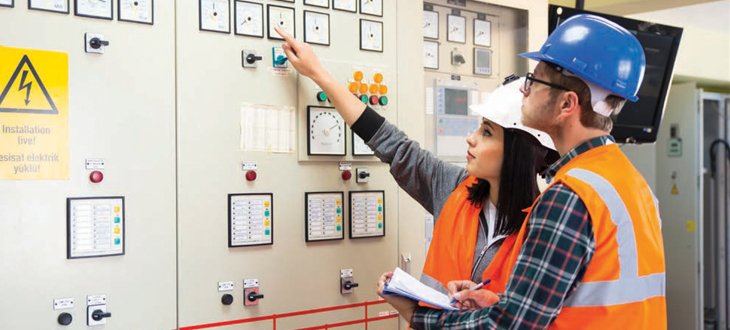
Electrical Preventative Maintenance — Powering a Healthier Bottom Line
As seen in Property Management Association’s publication Bulletin,
June 2018
By Todd Shatzer, Executive Vice President, Hawkins Electric Service, Inc.
On July 4th weekend in 2017, a 24-unit apartment community in the Baltimore–Washington metropolitan area lost power to the entire building. The cause, loose main feeder cables in the meter stacks, was highly preventable. But residents were displaced over the holiday weekend and the resulting emergency repairs cost the property management company tens of thousands of dollars.
This is just one recent example of how electrical equipment failure can create extremely costly emergencies. Fortunately, performing preventative maintenance on an electrical system can identify potential energy consumption and safety issues well before they become problematic. In addition, a regular preventative maintenance program provided by a full-service, qualified electrical contractor should significantly extend the life of a building’s electrical systems.
Emily Aschinger Martin of St. Louis-based Aschinger Electric, recently wrote about why more and more property managers are not kicking the expense of preventative maintenance down the road. In a May 2015 article posted on the National Electrical Manufacturers Association’s website, Martin writes, “The ROI with this maintenance program is typically very high due to the significant costs of installing new systems versus the relatively low cost of the program.”
How does electrical preventative maintenance support a healthier multifamily bottom line? To begin with, power consumption is costly. Efficient use of power generated by well-maintained electrical systems reduces the expense associated with those peak energy times of year.
Even more importantly, replacing older electrical equipment, such as switch gear and circuit breaker panels, with up-to-date equipment creates a safer environment for residents and tenants. Any serious injury or resulting loss of life due to operating under unsafe conditions may open up a company to costly liability.
In her NEMA article, Martin cited a report from Hartford Steam Boiler, a leading provider of equipment breakdown insurance, that showed “the failure rate of electrical equipment is three times higher for components that are not part of a scheduled (preventative) maintenance program than those that are.”
It Pays to Be Proactive
Martin lays out a three-step approach for electrical preventative maintenance, the following applies to the property management industry:
1. Maintain a customized checklist for the property. Items on a thorough inspection checklist should include switchgear, air circuit breakers, vacuum circuit breakers, air disconnect switches, oil circuit breakers, molded-case circuit breakers, battery stations and chargers, cables and bus, protective relays and uninterruptible power supply systems.
2. Trouble shoot for potential hazards and identify those that require immediate attention. A key diagnostic tool is an infrared scan that uses thermal technology to detect “hot spots” caused by defects in connections and components.
3. Maintain an accounting of the red-flag spots to look out for on a follow-up.
At Hawkins Electric Service, we provide multifamily clients with a report that categorizes potential hazards using a Level 1-2-3 scale. Level 1 is an emergency situation requiring immediate attention. Level 2 is a potential problem that needs to be scheduled for repair as soon as possible. Level 3 is aging equipment that needs to be considered for replacement in six months to a year.
How Often?
Property managers should have all of the equipment listed above serviced every three to five years. This includes:
- Tightening all connections to manufacturers’ specifications, using a torque screwdriver to avoid over-tightening or under-tightening.
- Cleaning; dusting; identifying worn, loose or missing parts; checking for unwanted water; and making sure batteries, lights and casings are in working order.
- Ventilation should also be part of the maintenance mix for all these areas.
How Much?
Depending on how much equipment is contained in a multifamily or commercial building, the cost of a complete preventative maintenance checkup can range from $5,000 to $25,000. While this may sound expensive, property managers need to keep in mind that the dollars are spread out over several years. Moreover, the cost of performing these preventative maintenance services is a fraction of the cost of failure of a major piece of electrical equipment such as a circuit breaker. Property managers also need to be aware that if an entire building goes down electrically, this poses a significant fire hazard.
Repair or Replace?
Martin writes, “The electrical contractor can and should be able to provide a cost-benefit analysis for property managers who are considering replacing their old systems with new ones. The ROI again is high in this case due to the significant potential savings in making a highly-informed, replace/no-replace decision when compared to the relative low cost of the cost–benefit analysis.”
 Top Success Tips
Top Success Tips
All things considered, here are the top success tips for profitable multifamily electrical preventative maintenance.
1. Budget to perform preventative maintenance work done every three to five years. Spending several thousand dollars every few years is far preferable to being hit with a bill for hundreds of thousands of dollars—when an entire high-rise goes down for weeks due to failed electrical equipment and hundreds of residents or tenants are displaced.
2. Make sure to use a contractor with qualified electricians certified in thermography. Maintenance/service technicians need to know how to operate an infrared camera and what to look for in terms of potential hazards.
3. In the same vein, hire a contractor that has a successful preventative maintenance and service track record in multifamily buildings. Better yet, look for a contractor that is a PMA member. That says a lot about their commitment to quality service and customer satisfaction in the multifamily industry.
Key Takeaway
If a property is older than five years, it needs to have a well-documented electrical preventative maintenance program in place. This means maintaining records that prove maintenance has been done. If there is a problem, an insurance company may ask to see inspection records with photos from a thermography camera as well as invoices for repairs.
When it comes to electrical preventative maintenance, property managers need to resist the all-too-human “out of sight, out of mind” attitude. While it can be hard to think about electrical panels or circuit breakers when everything is humming along smoothly, being proactive could be the key to avoiding a multifamily electrical catastrophe.
Back to all articles